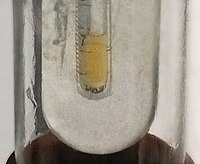
Photo from wikipedia
Abstract An experimental and numerical investigation of the thermochemical structure of piloted premixed jet flames was conducted, encompassing laser absorption tomography measurements and large-eddy simulations (LES). The investigation was performed… Click to show full abstract
Abstract An experimental and numerical investigation of the thermochemical structure of piloted premixed jet flames was conducted, encompassing laser absorption tomography measurements and large-eddy simulations (LES). The investigation was performed holding laminar flame speed, jet Reynolds number, and surrounding flow conditions constant while considering three different fuel types, namely an alkene, a normal alkane, and an aromatic fuel. Quantitative spatially-resolved thermochemical profiles of carbon monoxide (CO), carbon dioxide (CO2), and temperature obtained from laser absorption tomography were compared against profiles predicted by the simulations for premixed ethylene-, toluene-, and n-heptane-air flames. Variations in flow structure are observed for the different fuels, highlighting fuel-specific chemical effects on the spatial evolution of the flames. Quantitative agreement of laser absorption tomography and LES results is generally observed for all flames, with larger deviations observed in the nozzle-near region for the higher molecular-weight fuels, indicating potential deficiencies in the turbulent mixing models. To the authors’ knowledge, these measurements represent the largest molecular-weight fuels for which quantitative thermochemical data have been reported in a canonical piloted premixed jet-flame configuration. The spatially-resolved experimental measurements of CO, CO2, and gas temperature provide valuable data which can be used as validation targets for the development of turbulent combustion models.
Journal Title: Combustion and Flame
Year Published: 2020
Link to full text (if available)
Share on Social Media: Sign Up to like & get
recommendations!